Category: Explore
Italy
What is a Hostel?
Shall we understand what is a “Hostel” in Europe?
Quick history about Hostels:
- The first Hostel was in 1909.
- It was a German Hostel in Altena Castle created by a teacher, Richard Schirrmann.
- Hostels became popular post-World War II when people stated to travel more.
- Concept of a Hostel: The idea was to provide affordable lodging and a meet point for young travellers.
- Hostels offer dormitory-style rooms and communal spaces, fostering social interaction.
- Nowadays Hostels have changed a lot.
So, what are Hostels like now in 2024?
First of all, Hostels have undergone significant changes, especially post-COVID, due to travel restrictions and hygiene protocols. Many smaller hostels shutted down, allowing larger ones to expand. COVID precautions have also led to more spacious rooms, an increased private rooms options and upgraded amenities in common areas for enhanced hygiene and modern comfort.
Secondly, in today’s globalised world, where travel is more accessible, hostels continue to evolve to cater to diverse travellers. They adapt to new trends, offering a variety of experiences to suit every individual’s characteristics and budgets.
Type of Hostels you can find in Europe:
Hostels come in different shapes and sizes. Budget hostels offer cheap beds with almost no extras, perfect for saving money. Chain hostels have professional staff and great amenities for a comfortable stay. Boutique hostels give that hotel-like vibe but keep the social atmosphere.
- Youth hostels
- Backpacker hostels
- Luxurious/Boutique Hostels
- Party/Events/Social Hostels
- Eco-Friendly Hostels
- Themed Hostels
- Activity Hostels
- Digital Nomad Hostels
- Cheap Hostels
- Family-Friendly Hostels
The nice thing is that you can find the best Hostel that works for you!
What will you find inside a Hostel?
Types of Accommodations
Dorm Rooms
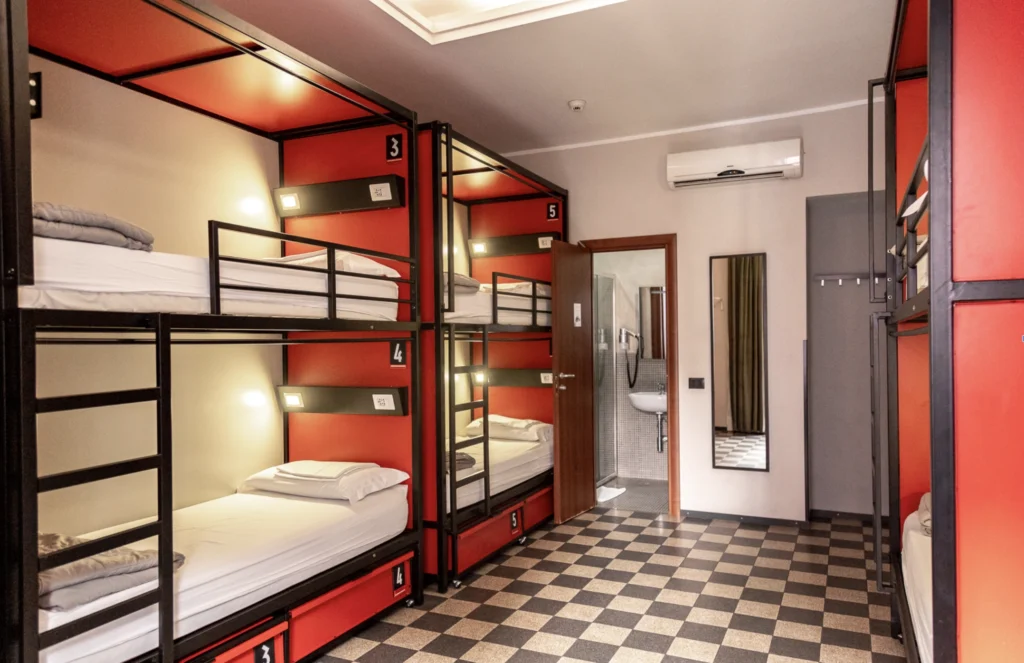
Dorm rooms are shared accommodations with multiple beds in one room. You get a bunk bed, a locker for your stuff, sometimes a safer and shared bathroom facilities or ensuite shared bathroom. Ideal for budget travellers who want to meet people and share experiences.
Private Rooms
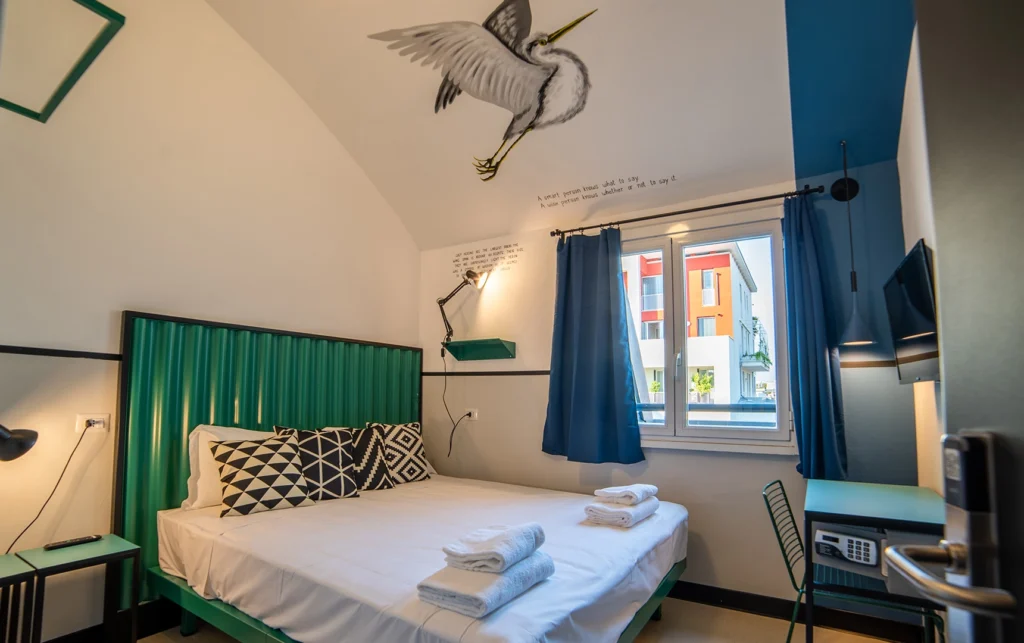
A private room in a hostel gives you your own space or for more people with a lockable door. Privacy together with the social vibe of a hostel. You might also find a private bathroom, ensuite bathroom, desk, or even a TV depending on the Hostel. Perfect for those who want privacy, a bit more comfort and still get the sense of community.
Spaces in a Hostel
1) Common Areas
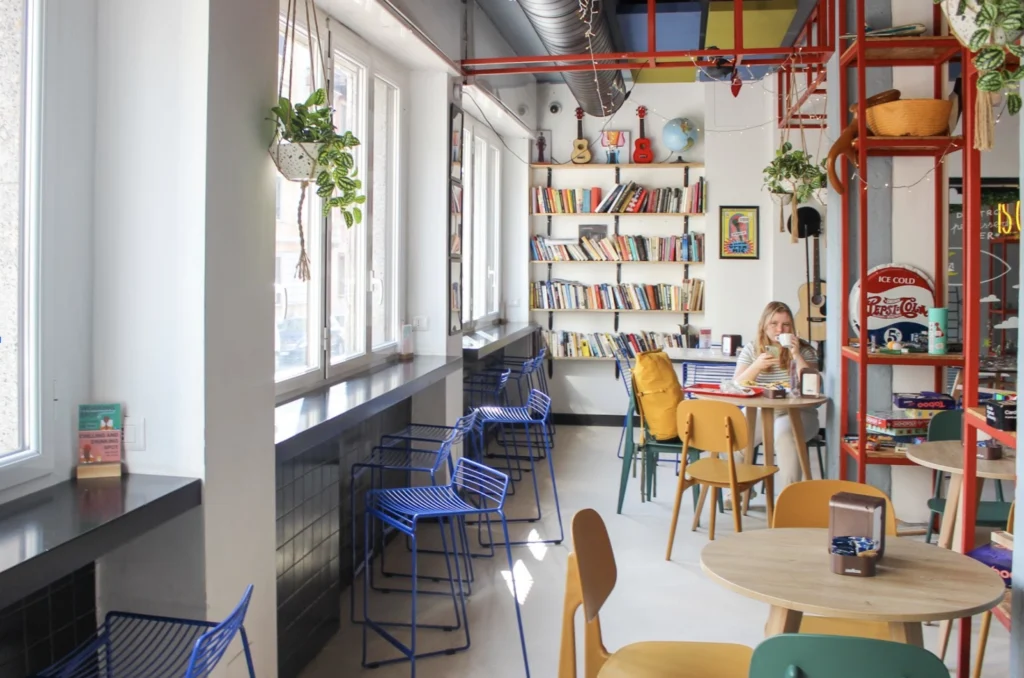
Common Areas are a very important part of a Hostel. It is where you can chill and relax, but also have the first interactions with other travellers. These spaces often have libraries with exchangeable books, music instruments or table games. Everyone is supposed to take care of shared areas.
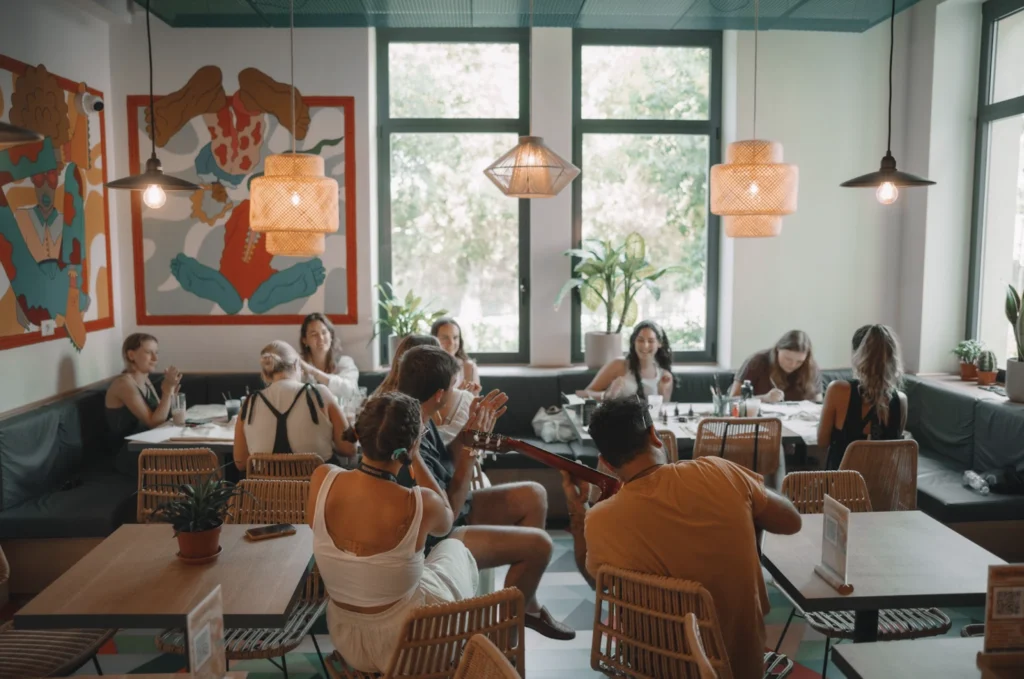
2) Common Kitchen
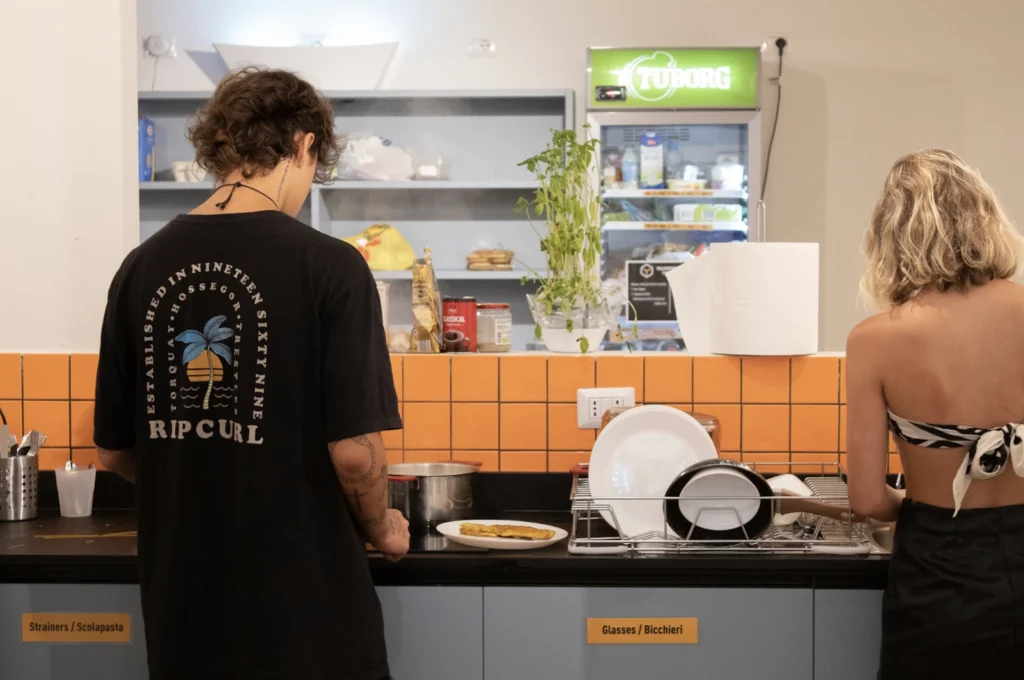
A hostel will always have a common kitchen! It is a vital part of a Hostel for travellers. You can save money eating at the hostel and conserving food in the fridge, also it will allow you to only eat out when you consider it important or valuable to you.
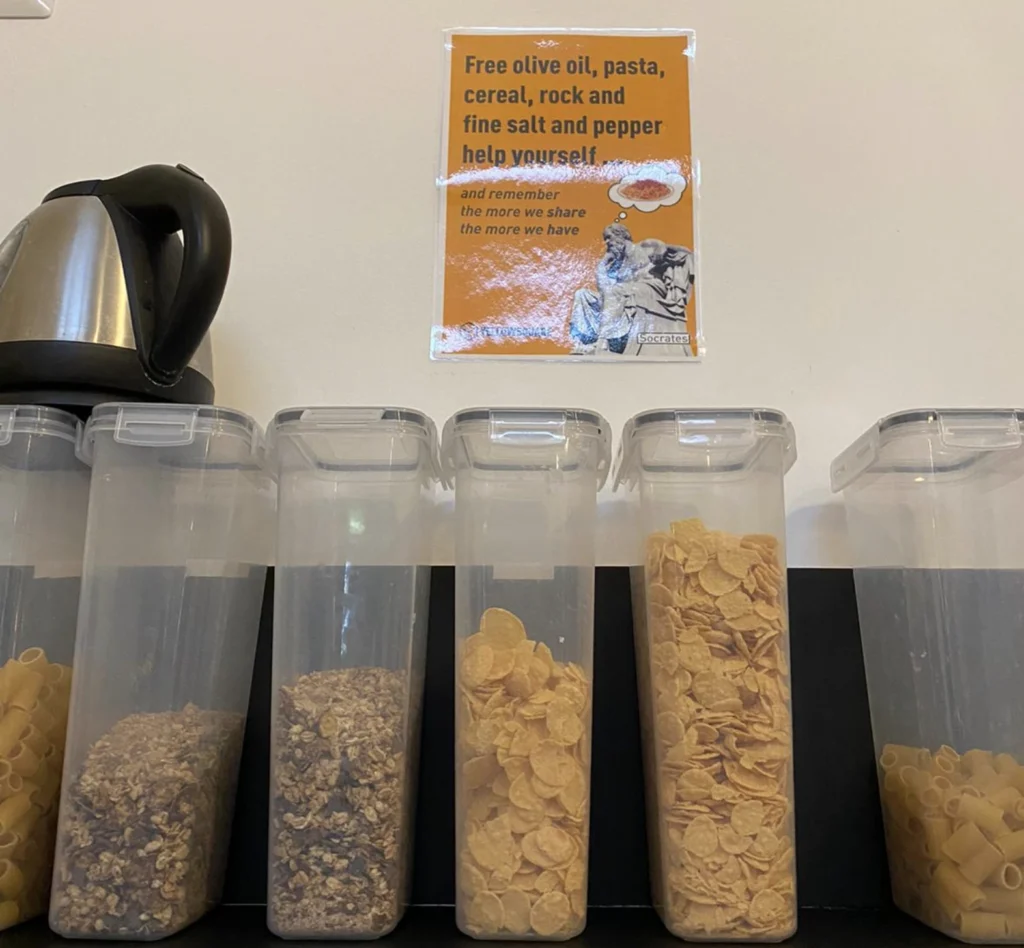
Usually hostels give some free food as free olive oil, pasta, cereal, salt, sugar, pepper (It might change from country to country, I’m sure having a good OLIVE oil disposable is almost only in Italy =) ).
It will also be the moment to make lunch or dinner with other travellers, after being away from home, it might be one of the few things to bring you back home while travelling the world: A nice family dinner! Knowing new cultures and tastes, sharing skills and histories.
3) Restaurant/Bar
Many hostels now have also an inside restaurant

You can check the menu online:
YellowSquare Rome menu
YellowSquare Milan menu
YellowSquare Florence menu
4) Rooftops
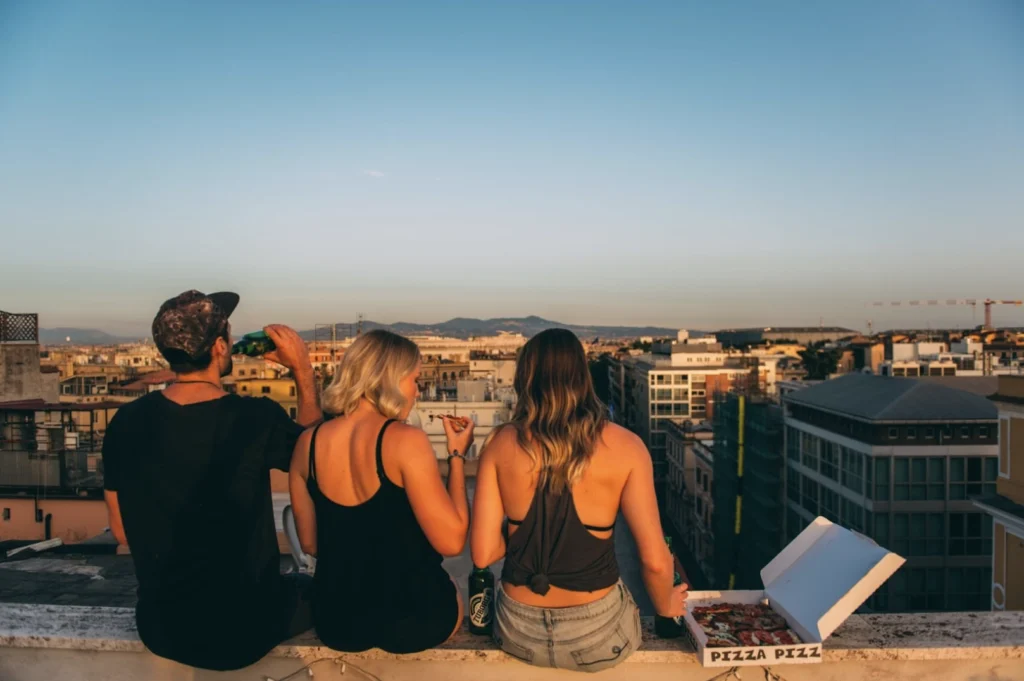
5) Swimming Pool
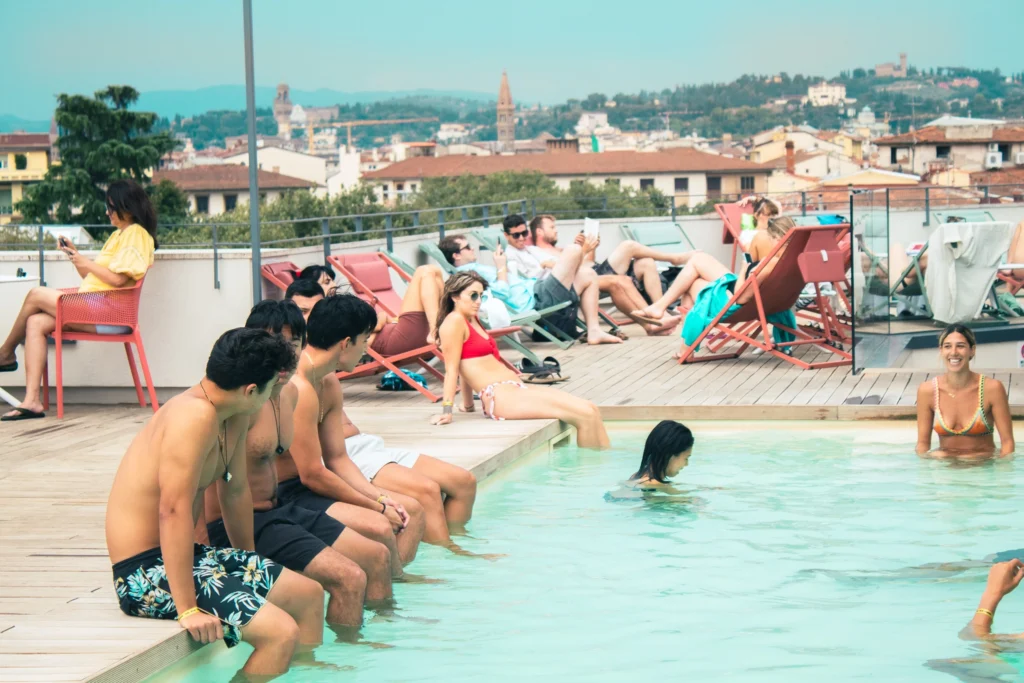
6) Co-working spaces

7) Hair Salon
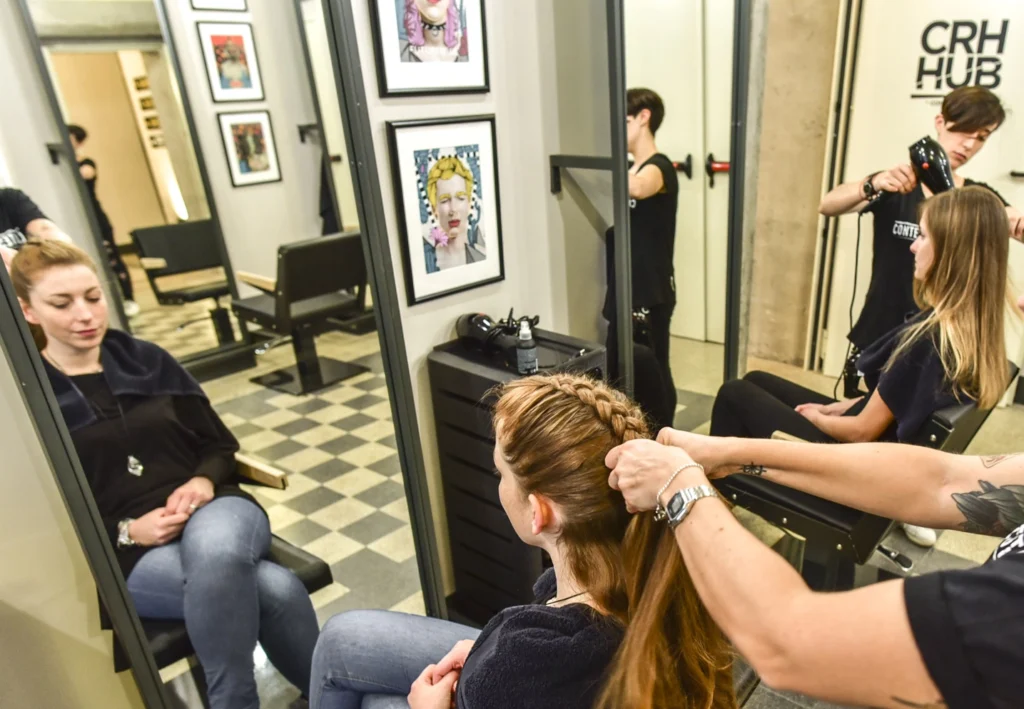
It will depend on the Hostel, but the variety of common places is nice to live the hostel vibe and socialise.
Facilities
Facilities though are very important to have the minimum confort, safety and know what to pack when staying in a Hostel.
Always check them in the websites before booking. =)
- Free wi-fi
- Reception 24h (Not all Hostels, but a majority)
- Luggage storage: free at check-in and storage for rent in any moment
- Laundry: Laundry machines inside the hostel
- Towels: free for private rooms and for rent for dorm rooms.
- Cleaning service in the morning.
A little bit about the social life in Hostels…
When you are in a Hostel, make an effort to participate in the activities and events. These are the moments that provide valuable opportunities to build friendships, which is especially meaningful for solo travellers. These experiences make the stay unforgettable and memorable for life. It also contributes to feeling more connected to the local culture and community, such as being open for locals to enter/live the hostels, but also tours to local shops, workshop and dance class with local people, and much more!
It can actually be said that this is a vital part of hostels that differentiate them from hotels, airbnb and rent houses.
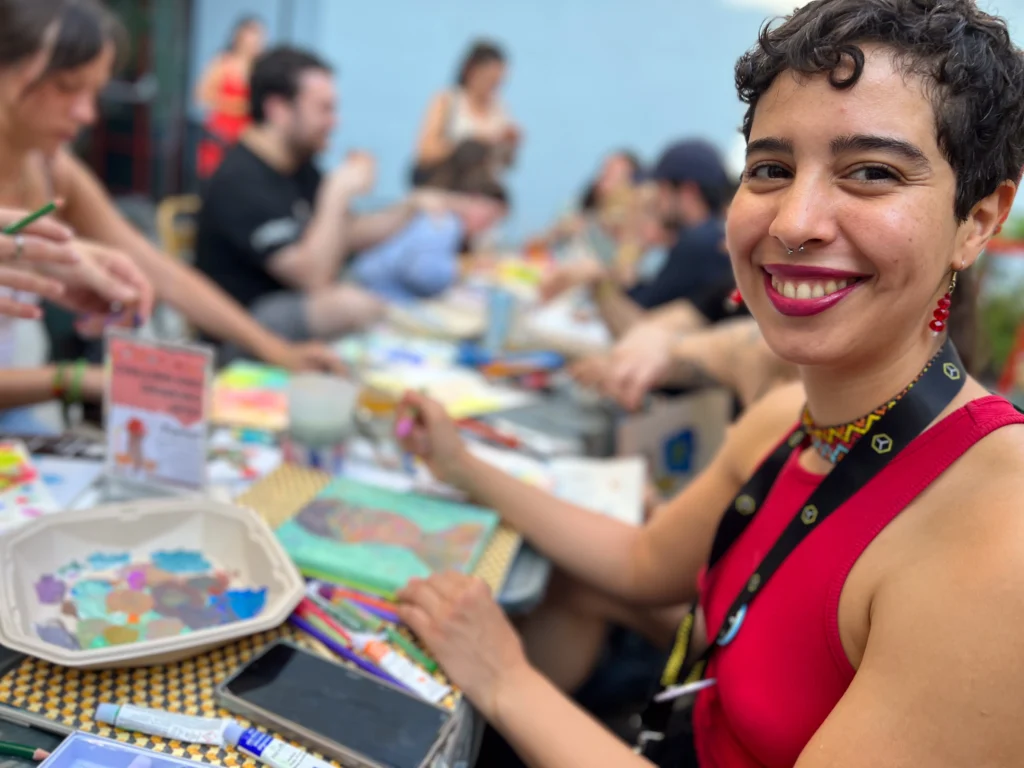
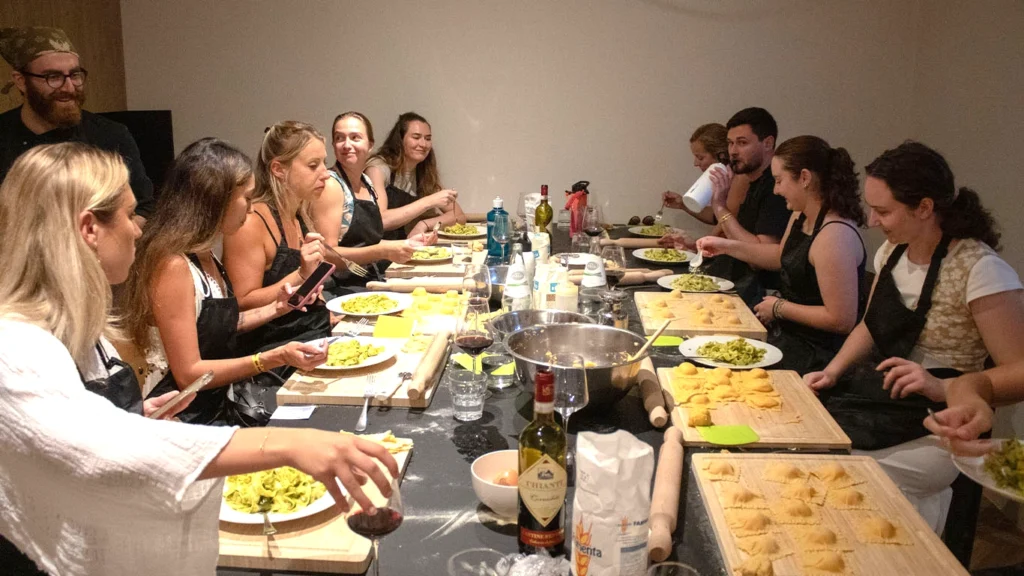
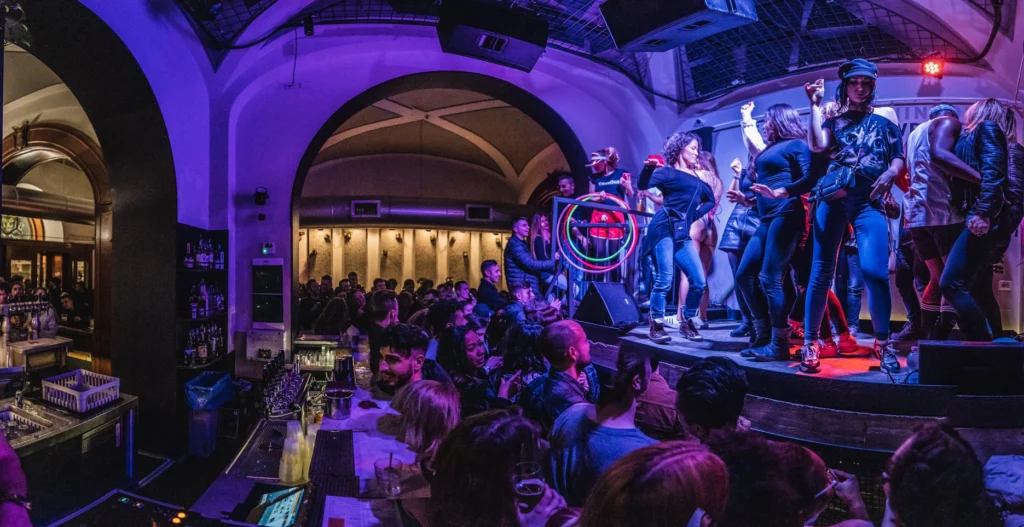
How long can you stay in a Hostel?
Usually you can book in a Hostel for a maximum of 15 nights and they might offer you an extended option with a discount for those who desire to stay longer or had a change of plans at last minute. In Europe it is common to stay no that many days in a Hostel since people take a long time travelling but splitted in many different countries, the so called “Europe Trip”. It’s interesting to consider that however making longer stays and taking time to know places is a new factor in the trend of eco-travelling. It’s often called “slow travel” which means take your time with less footprint carbon emissions and give more to local communities. Read more here in our “Slow Travel article”.
The Bright side of staying in a Hostel?
Staying in a hostel offers a vibrant social atmosphere, ideal for making new friends. It provides budget-friendly accommodations, unforgettable travel experiences. Hostels often offer local insights, activities, events and parties .
The not so bright part of staying in a Hostel
1) Not having table service or room service.
If you are hoping and expecting that kind of service, that is one thing you won’t find in a Hostel. Hostels are more the type of “help yourself” thing. Though, many hostels also help you with your luggage =)
2) Do not stay in a Hostel if you want your own space, do not interact and do not meet new people.
*Even though there are so many common spaces, you can usually find a way to read your book and be at peace by yourself when needed!
It would probably be the only two things for not staying in a Hostel, because to be honest, now people have so many types of hostels to choose from: if you want breakfast included… you can find a hostel with that option. You do not want to share a room or a bathroom, you can also find private rooms. You want a more luxurious spot… and yet Boutique Hostels are becoming a trend and growing in numbers.
It’s more something like: Find the perfect hostels that fits you!
Where to find a Hostel?
- Hostelworld: is the most famous website specific for Hostels.
- Booking.com: You can always find options for all types of stays.
- Hostelz: is a website that compares all Hostel rates and prices avalaible on the internet for you.
- Just search on google filtering by the city you want to stay in and check reviews.
- Go to the Hostel Official website you liked the most in your research. You might find a lower cost and discounts =)
Top 10 hostels in europe according to Hostelworld (2024):
- St Christopher’s Gare du Nord, Paris
- Generator Hostel, London
- ClinkNoord, Amsterdam
- The YellowSquare
- Castle Rock Hostel, Edinburgh
- Ostello Bello Grande, Milan
- Sant Jordi Rock Palace, Barcelona
- Czech Inn, Prague
- Wombats City Hostel, Berlin
- Isaacs Hostel, Dublin
Read more posts
Rome
Six Months Rome Insights
Hey dude! Hope you’re doing great! If you’re thinking about coming to Rome for the first time, I have to admit, I’m a bit envious. I still remember the excitement of seeing this city for the first time—it captivated me so much that I decided to stay.
I’ll do my best to give you a snapshot of how I’ve experienced this city over the last few months.
Where Anything Can Happen
Rome is that city where anything can happen. On any given Wednesday, you might see James Franco in Trastevere signing books or Harry Styles at Porta Portese buying rare vinyl records. And if that doesn’t surprise you, wait until the following week when Edward Norton (the other guy from Fight Club) presents a movie at an open-air cinema. That’s Rome for you: a box full of infinite surprises. How would I define it? In one word: stimulating.
Check more here:
https://www.romeinternational.it/en/edward-norton-in-rome-meet-the-public/https://cinematroisi.it/
“James Franco presenta Spring Breakers a Monte Ciocci”
“Edward Norton a Roma parla del Cinema Italiano al Cinema in Piazza di Roma”
A Cultural Mosaic
Rome is the Tower of Babel, but with more flavor and better coffee. Here, cultures don’t just coexist; they embrace each other in a delicious chaos that only this city can offer. Walk through its streets, and you’ll hear a symphony of languages, see markets filled with products you didn’t know existed, and discover trattorias where every dish tells a story. Trust me, Rome is a place that embraces. It’s a festival of diversity wrapped in perfectly orchestrated chaos.
Food: More Than Just a Cliché
When I first arrived, I remember being amused by what I considered a parade of neurotics obsessed with details. But I have to admit, this obsession with culinary precision, which is practically a matter of general culture in Italy, results in the lowest standard of food here being excellent.
And after a while, trust me, you learn that pecorino is sacred, the guanciale vs. pancetta debate and their proper uses, plot twist (there’s more than just spaghetti), pasta must always be al dente, fish and cheese can get you kicked out of Italy, what a “normal coffee” really means, and so much more.
Roman Philosophy in Two Words: Sti Cazz$
So, one day I was talking to my friend Manuele (a Roman chef, true to the stereotype) about what sti cazz$ really means. He told me, “It’s like saying ‘who cares,’ but it’s more than that.” That’s how you survive in Rome. The metro is late? Sti cazz#. Your dinner came out late? The waiter messed up your order? Sti cazz$. Basically, nothing is serious enough to worry too much about. Everything has a solution, and if it doesn’t… sti cazz$.
(Disclaimer!! please, don’t search the word on Google Images)
Ci vediamo presto!
Okay, my fellow travelers, all roads lead to Rome. I’ve barely scratched the surface of what you can find here, but trust me, it’s worth the journey.
See you here for an aperitivo!
Pura Vida, Ale
Read more posts
Rome
PLACES TO VISIT IN ROME: COPPEDè DISTRICT
Before it all, check our previous blogpost: From The YellowSquare Hostel to Michelangelo’s Masterpiece
The so-called Quartiere Coppedè is a part of the hidden secrets in Rome, a complex of palaces and small villas in the Trieste district.
Around 1915, the Società Anonima Edilizia Moderna embarked on a new housing complex to be constructed in Rome, in an area between the Salario and Trieste districts, near the border of Parioli.
The chosen architect was Gino Coppedè from Florence, a brilliant personality who tackled a challenging theme in Rome for the first time. It’s why it owns the name Coppedè as your creator architect.
Quartiere Coppedè is instantly recognizable for its magnificent blend of artistic and architectural styles.
This unique corner of Rome is a fascinating experiment that merges Art Nouveau, Art Deco, Gothic, and Mediaeval influences with Greek and Roman art. Every turn reveals a new blend of styles, creating a fantastical mixture that is both enchanting and memorable.
Whether you’re an architecture enthusiast or simply a curious traveller, Quartiere Coppedè offers a delightful and unexpected experience in the heart of Rome.
What to see in Coppedè District?
Discover 4 unusual spots at Coppedè quartier.
1. The Dramatic Arched Entranceway
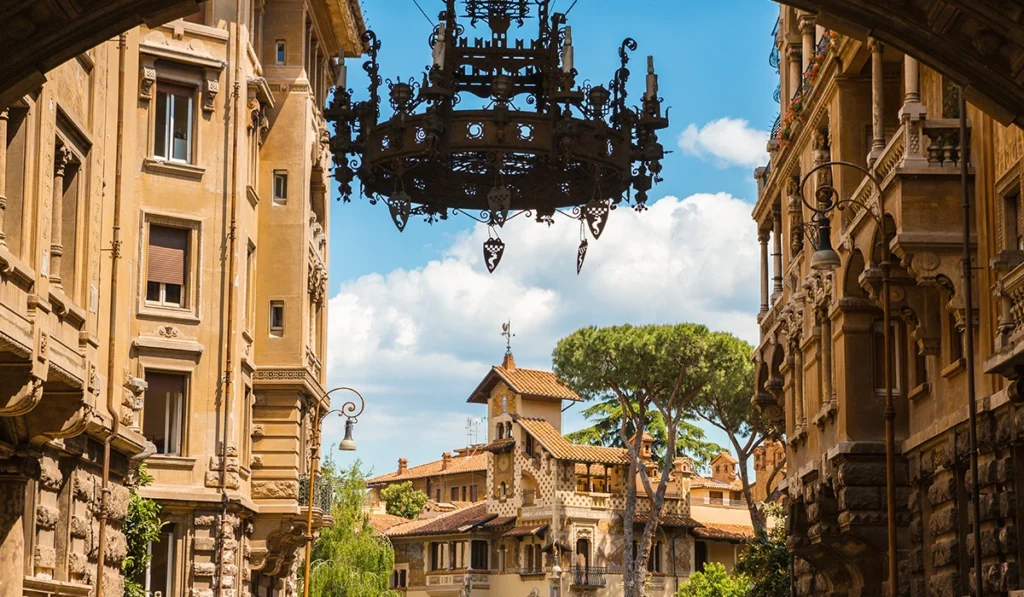
Step into the whimsical world of Quartiere Coppedè through its grand arched entrance on Via Dora. An intricate iron chandelier with floral twists and seahorse motifs draws you into this hidden gem of Rome, promising an adventure filled with architectural marvels.
2. The Fountain of the Frogs
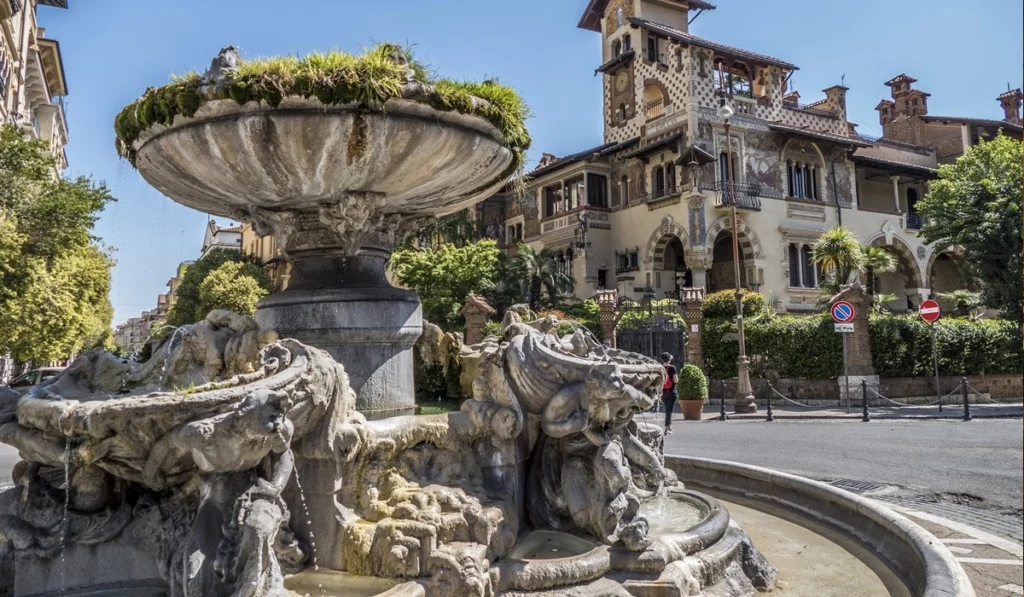
Designed by the renowned architect Gino Coppedè in 1924, the Fontana delle Rane (Fountain of the Frogs) is a lively tribute to Bernini’s iconic fountains. Its low pond and vibrant composition will transport you to a bygone era. This spot gained legendary status when the Beatles famously jumped into it after a nearby concert at Piper Club in 1965.
3. The Spider Palace
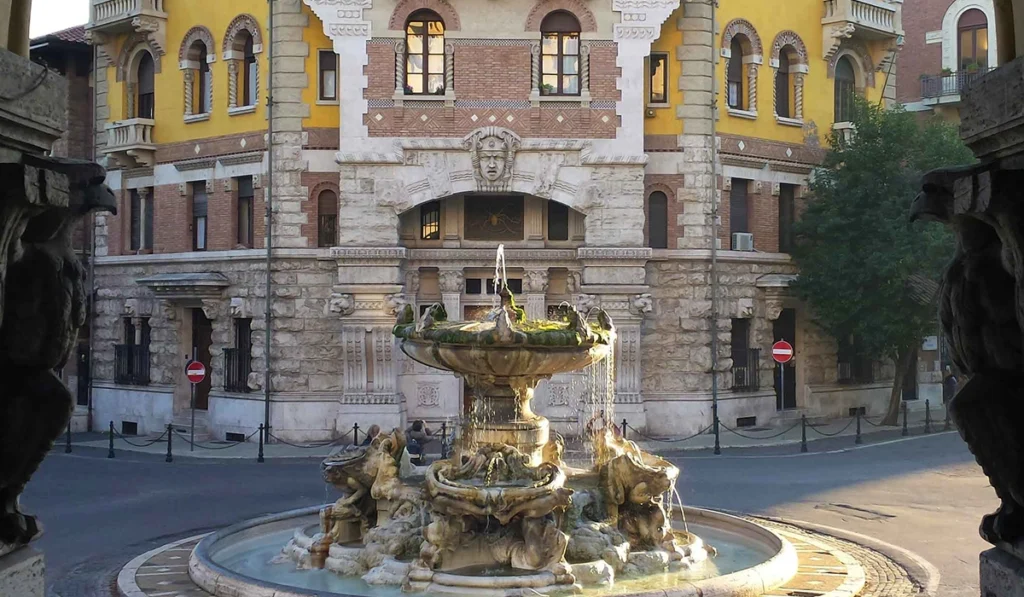
At Piazza Mincio 4, the Palazzo del Ragno (Spider Palace) stands out with its large spider decoration above the wooden doorway. Take a step back to appreciate its other fascinating details, including a prominent face, lion heads, griffins, various columns, a balcony with a loggia, and beautiful frescoes on the facade. It’s a building that invites endless exploration.
4. The Fairy Houses
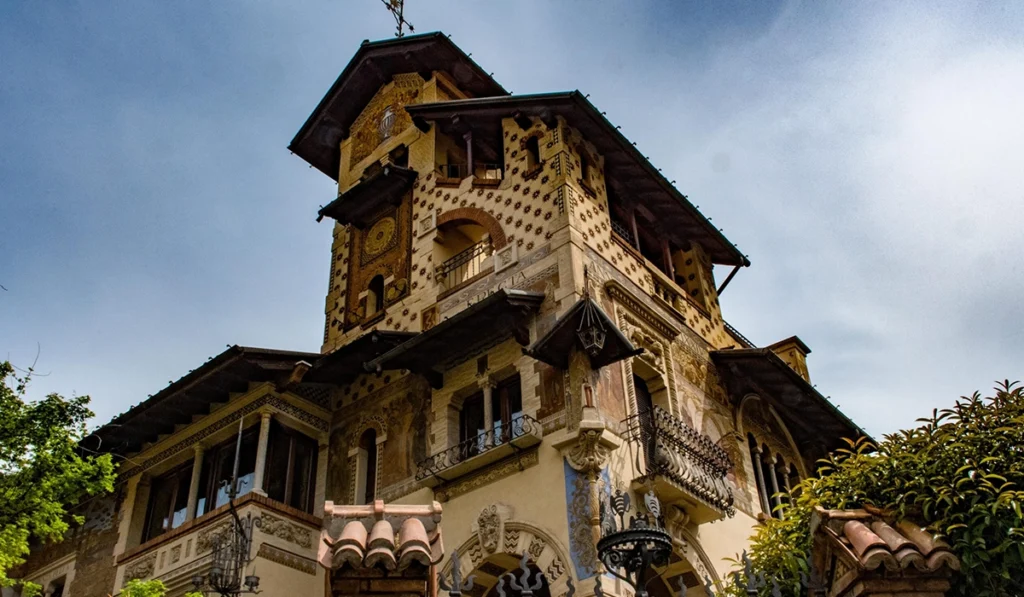
Scattered across via Aterno 4, piazza Mincio 3, and via Brenta 7-11, the Villino delle Fate (Fairy Houses) are a magical sight. These enchanting residences add a touch of fairy-tale charm to the eclectic neighbourhood, each one brimming with unique architectural details that make a stroll through Quartiere Coppedè an unforgettable experience.
Where to eat or have a coffee nearby Coppedè district:
Good restaurants from Piazza Mincio.
- Pizzeria e Ristorante Gaudì: 10 min walk
- Roman Restaurant Al Simeto: 7 min walk
- Trattoria at good price La Balestra: 8 min walk
Nice cafè around the corner.
- Tribeca Cafè (also open for lunch and dinner): 10 min walk
- Classic and simple Coppedè Cafè: 3 min walk
How to get to the Coppedè district in Rom:
As it is off the touristic path, it can be worth it to check from where you stay to arrive at the neighbourhood.
- The nearest metro station is metro Policlinico.
1-From the metro station Policlinico you can walk 21min to Piazza Mincio
2-Or you can catch the TRAM 19NAV – 2min walk (170m) from the metro station.
From the stop V.Le Regina Margherita/Morgagni to the stop Piazza Buenos Aires. And only walk 3 min to Piazza Mincio.
- Another option is to catch the bus 92 Marliana at Termini station till the stop Tagliamento/Clitunno and walk 2 minutes to get to Piazza Mincio.
Have a nice one!
Read more posts
Rome
From The YellowSquare Hostel to Michelangelo's Masterpiece
Hey there, travelers! Ready to uncover one of Rome’s most famous treasures—the Sistine Chapel? Let’s dive into the fascinating history of this awe-inspiring masterpiece and make our way there step by step from The Yellow Hostel.
Where It All Began
The Sistine Chapel’s story starts in the late 15th century when Pope Sixtus IV decided to create a place worthy of divine worship. Little did he know, he was setting the stage for one of the greatest artistic achievements of all time!
Fast forward a bit, and enter Michelangelo—the artistic genius tasked with painting the chapel’s ceiling. For four years, he poured his heart and soul into creating breathtaking frescoes that still leave visitors in awe today.
Aside from its stunning beauty, the Sistine Chapel has played a crucial role in history. It’s where papal conclaves gather to elect new popes—a tradition that’s been going strong for centuries!
Navigating to the Sistine Chapel from The Yellow Hostel
Okay, time to hit the road! Leave The Yellow Hostel and head northeast on Via Cavour. Keep an eye out for cool shops and cafes along the way!
As you stroll along Via XX Settembre, you’ll pass by the majestic Palazzo del Quirinale. Don’t forget to snap a few pics of this impressive building!
Next up, you’ll come to Ponte Sant’Angelo—a historic bridge adorned with beautiful angel sculptures. Cross it to get to the Vatican Museums.
Follow the signs to the Sistine Chapel as you make your way through the Vatican Museums. Trust us, you won’t want to miss this!
As you step into the Sistine Chapel, get ready to have your mind blown. Look up, and you’ll see Michelangelo’s incredible ceiling frescoes depicting scenes from the Bible.
Now, don’t rush! Take your time to admire every detail of Michelangelo’s masterpiece, including his epic fresco “The Last Judgment” on the altar wall.
There’s something truly special about standing in a place that’s witnessed centuries of history. Soak in the spiritual atmosphere and let yourself be transported back in time.
Back at the hostel, take a moment to reflect on your incredible journey. Share your experiences with fellow travelers and maybe even sketch your own masterpiece!
Safe travels, adventurers!
